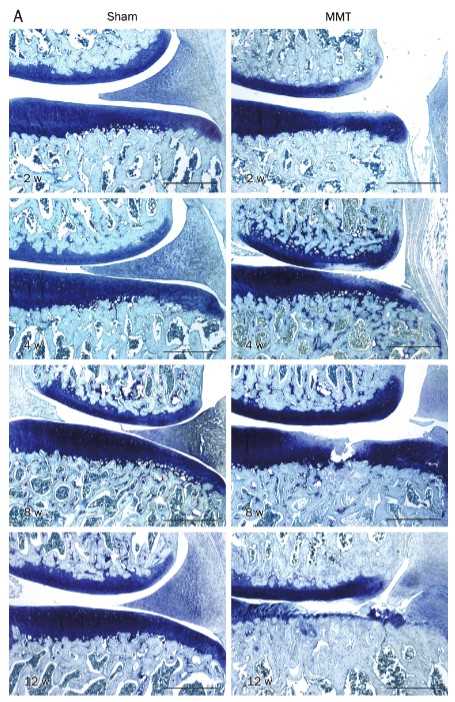- You are here: Home
- Services
- Disease Models
- Orthopedic Disease Models
- Osteoarthritis (OA) Model
- Medial Meniscal Tear (MMT)-Induced Osteoarthritis (OA) Model
Services
-
Cell Services
- Cell Line Authentication
- Cell Surface Marker Validation Service
-
Cell Line Testing and Assays
- Toxicology Assay
- Drug-Resistant Cell Models
- Cell Viability Assays
- Cell Proliferation Assays
- Cell Migration Assays
- Soft Agar Colony Formation Assay Service
- SRB Assay
- Cell Apoptosis Assays
- Cell Cycle Assays
- Cell Angiogenesis Assays
- DNA/RNA Extraction
- Custom Cell & Tissue Lysate Service
- Cellular Phosphorylation Assays
- Stability Testing
- Sterility Testing
- Endotoxin Detection and Removal
- Phagocytosis Assays
- Cell-Based Screening and Profiling Services
- 3D-Based Services
- Custom Cell Services
- Cell-based LNP Evaluation
-
Stem Cell Research
- iPSC Generation
- iPSC Characterization
-
iPSC Differentiation
- Neural Stem Cells Differentiation Service from iPSC
- Astrocyte Differentiation Service from iPSC
- Retinal Pigment Epithelium (RPE) Differentiation Service from iPSC
- Cardiomyocyte Differentiation Service from iPSC
- T Cell, NK Cell Differentiation Service from iPSC
- Hepatocyte Differentiation Service from iPSC
- Beta Cell Differentiation Service from iPSC
- Brain Organoid Differentiation Service from iPSC
- Cardiac Organoid Differentiation Service from iPSC
- Kidney Organoid Differentiation Service from iPSC
- GABAnergic Neuron Differentiation Service from iPSC
- Undifferentiated iPSC Detection
- iPSC Gene Editing
- iPSC Expanding Service
- MSC Services
- Stem Cell Assay Development and Screening
- Cell Immortalization
-
ISH/FISH Services
- In Situ Hybridization (ISH) & RNAscope Service
- Fluorescent In Situ Hybridization
- FISH Probe Design, Synthesis and Testing Service
-
FISH Applications
- Multicolor FISH (M-FISH) Analysis
- Chromosome Analysis of ES and iPS Cells
- RNA FISH in Plant Service
- Mouse Model and PDX Analysis (FISH)
- Cell Transplantation Analysis (FISH)
- In Situ Detection of CAR-T Cells & Oncolytic Viruses
- CAR-T/CAR-NK Target Assessment Service (ISH)
- ImmunoFISH Analysis (FISH+IHC)
- Splice Variant Analysis (FISH)
- Telomere Length Analysis (Q-FISH)
- Telomere Length Analysis (qPCR assay)
- FISH Analysis of Microorganisms
- Neoplasms FISH Analysis
- CARD-FISH for Environmental Microorganisms (FISH)
- FISH Quality Control Services
- QuantiGene Plex Assay
- Circulating Tumor Cell (CTC) FISH
- mtRNA Analysis (FISH)
- In Situ Detection of Chemokines/Cytokines
- In Situ Detection of Virus
- Transgene Mapping (FISH)
- Transgene Mapping (Locus Amplification & Sequencing)
- Stable Cell Line Genetic Stability Testing
- Genetic Stability Testing (Locus Amplification & Sequencing + ddPCR)
- Clonality Analysis Service (FISH)
- Karyotyping (G-banded) Service
- Animal Chromosome Analysis (G-banded) Service
- I-FISH Service
- AAV Biodistribution Analysis (RNA ISH)
- Molecular Karyotyping (aCGH)
- Droplet Digital PCR (ddPCR) Service
- Digital ISH Image Quantification and Statistical Analysis
- SCE (Sister Chromatid Exchange) Analysis
- Biosample Services
- Histology Services
- Exosome Research Services
- In Vitro DMPK Services
-
In Vivo DMPK Services
- Pharmacokinetic and Toxicokinetic
- PK/PD Biomarker Analysis
- Bioavailability and Bioequivalence
- Bioanalytical Package
- Metabolite Profiling and Identification
- In Vivo Toxicity Study
- Mass Balance, Excretion and Expired Air Collection
- Administration Routes and Biofluid Sampling
- Quantitative Tissue Distribution
- Target Tissue Exposure
- In Vivo Blood-Brain-Barrier Assay
- Drug Toxicity Services
Medial Meniscal Tear (MMT)-Induced Osteoarthritis (OA) Model
As one of the most well-recognized experts in the field of osteoarthritis (OA) research, Creative Bioarray takes pride in delivering exceptional services tailored to our clients' needs. We specialize in the development and optimization of OA models, and one of our key services is the establishment of a stable OA model induced by medial meniscal tear (MMT). By leveraging this model, we can help you gain a deeper understanding of OA or evaluate the efficacy of your drug candidates.
Osteoarthritis, a degenerative disease that gradually worsens over time, is often accompanied by chronic pain, significantly affecting patients' quality of life. Characterized as a chronic, progressive, and multifactorial condition, OA leads to a steady decline in the structure and function of articular cartilage, primarily affecting middle-aged and older individuals. Given the escalating incidence of this condition, there has been a surge in the utilization of animal models as a crucial tool to enhance our understanding of OA pathogenesis and to explore potential therapeutic options throughout various stages of disease progression. Over the years, the medial meniscal tear (MMT) model has proven to be an extensively utilized platform for assessing the efficacy of potential anti-arthritic agents and evaluating the disease-modifying effects of various treatments.
Our Medial Meniscal Tear (MMT)-Induced Osteoarthritis (OA) Model
- Available Animal
Rat - Modeling Method
Rats are anesthetized and the right knee area is prepared for surgery. The medial collateral ligament of the right knee is transected, and the medial meniscus is reflected proximally toward the femur and cut through at its narrowest point. - Endpoints
- Body weight
- Behavioral tests
- Histology analysis (knee joint): H&E staining, Toluidine blue staining
- Cytokine analysis
- Other customized endpoints
Example Data
 Fig. 1 Changes in articular cartilage during OA progression. (A) Representative images with toluidine blue O staining.
Fig. 1 Changes in articular cartilage during OA progression. (A) Representative images with toluidine blue O staining.
In addition, we also provide other OA models that maybe you are interested in:
- Monosodium Iodoacetate (MIA)-Induced Osteoarthritis (OA) Model
- Papain-Induced Osteoarthritis (OA) Model
- Anterior Cruciate Ligament Transection (ACLT)-Induced Osteoarthritis (OA) Model
Quotation and Ordering
Creative Bioarray, a leading CRO partner, offers world-class services in the realm of in vivo efficacy studies. If you are interested in our services, please do not hesitate to contact us at any time or submit an inquiry to us directly. We look forward to cooperating with you.
Reference
- Yu, D., et al. Efficacy of zoledronic acid in treatment of teoarthritis is dependent on the disease progression stage in rat medial meniscal tear model. Acta pharmacologica Sinica, 2012, 33(7): 924-934.
Explore Other Options
For research use only. Not for any other purpose.

